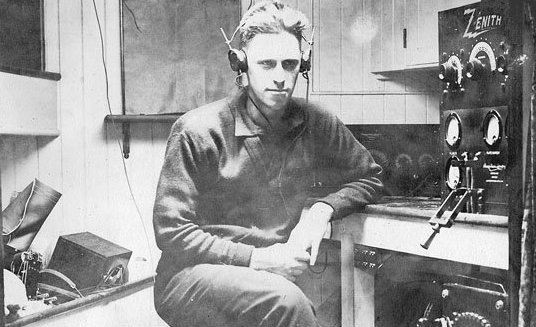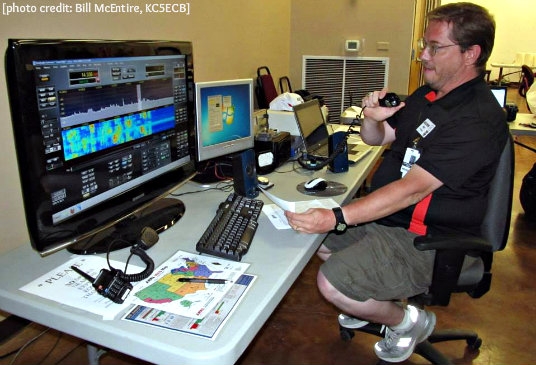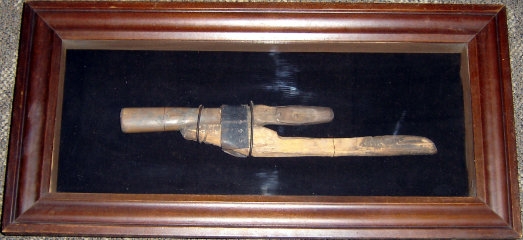
In 1873, James Clerk Maxwell presented his theory of the electromagnetic field. In 1901 Guglielmo Marconi communicated across the Atlantic with a radio device using high power and giant antennas. To curb interference, Congress approved the Radio Act of 1912, which required amateurs to be licensed and restricted to the single wavelength of 200 meters. In 1914 the American Radio Relay League was founded by Hiram Percy Maxim, who found that messages could be sent more reliably over long distances if relay stations were organized. Transatlantic transmitting and receiving tests began in 1921 and by July 1960 the first two-way contact via the Moon took place on 1296 MHz.
Today we’re on CW, phone, SSB, FM, packet, TV, PACTOR, PSK31, RTTY, and other modes, bouncing signals off the ground, ionosphere, and the Moon. Hams are active in nearly every country of the world and from ages less than 10 years to more than 100. Read More

What is Ham Radio?
Amateur Radio (Ham Radio) is a popular hobby and a service in which licensed participants operate communications equipment. Read More
Radio Equipment
Historical Terms
-
Ham: a poor operator; a 'plug' (G. M. Dodge; The Telegraph Instructor)
The first wireless operators were landline telegraphers who left their offices to go to sea or to man the coastal stations. They brought with them their language and much of the tradition of their older profession. In those early days, every station occupied the whole spectrum with its broad spark signal. Government stations, ships, coastal stations and the increasingly numerous amateur operators all competed for time and signal supremacy in each other's receivers. Many of the amateur stations were very powerful. Two amateurs, working each other across town, could effectively jam all the other operations in the area. Frustrated commercial operators would refer to the ham radio interference by calling them "hams." Amateurs, possibly unfamiliar with the real meaning of the term, picked it up and applied it to themselves. As the years advanced, the original meaning has completely disappeared.
-
The Q Code came into being internationally in 1912 to overcome the language problems involved in communications by radio among ships and shore stations of all countries. The original list of 50 adopted by international agreement in London contain many which are still familiar to amateur operators-QRN, QRM, QSO, the traffic operator's QRK, QSY and QRV - are now nearing the century mark of continuous usage. QSL still has the official 1912 definition despite the changed informal usages it is subjected to in amateur parlance.
The QN signals for amateur net operation were introduced in the late 1930s by E. L. Battey W1UE (W4IA-SK) to lighten the burdens of net control operators.
-
The telegraph call CQ was born on the English Telegraph over a century ago as a signal meaning "All stations. A notification to all postal telegraph offices to receive the message." Its meaning was close to the present meanings of QNC and QST. Like many other telegraph terms which originated on the landlines, CQ was brought over into radio and used as a general call to all ships by the Marconi Company. Other companies used KA until the London Convention of 1912, which adopted CQ as the international general call or "attention" signal. CQ still means, literally, "attention" but in amateur radio its meaning is perhaps more accurately described by Thomas Raddell who compared it to yelling "Hey, Mac!" down a drain pipe.
But why the letters CQ? From the French, sécurité, (safety or, as intended here, "pay attention"). Later, the origin of the abbreviation was changed to the phrase "seek you."
-
The traditional expression "73" goes right back to the beginning of the landline telegraph days. It is found in some of the earliest editions of the numerical codes, each with a different definition, but each with the same idea in mind--it indicated that the end, or signature, was coming up. But there are no data to prove that any of these were used.
The first authentic use of 73 is in the publication The National Telegraph Review and Operators' Guide, first published in April 1857. At that time, 73 meant "My love to you!" Succeeding issues of this publication continued to use this definition of the term. Curiously enough, some of the other numerals then used have the same definition now that they had then, but within a short time, the use of 73 began to change.
In the National Telegraph Convention, the numeral was changed from the Valentine-type sentiment to a vague sign of fraternalism. Here, 73 was a greeting, a friendly "word" between operators and it was so used on all wires.
In 1859, the Western Union Company set up the standard "92 Code". A list of numerals from one to 92 was compiled to indicate a series of prepared phrases for use by the operators on the wires. Here, in the 92 Code, 73 changes from a fraternal sign to a very flowery "accept my compliments," which was in keeping with the florid language of that era.
Over the years from 1859 to 1900, the many manuals of telegraphy show variations of this meaning. Dodge's The Telegraph Instructor shows it merely as "compliments." The Twentieth Century Manual of Railway and Commercial Telegraphy defines it two ways, one listing as "my compliments to you;" but in the glossary of abbreviations it is merely "compliments." Theodore A. Edison's Telegraphy Self-Taught shows a return to "accept my compliments." By 1908, however, a later edition of the Dodge Manual gives us today's definition of "best regards" with a backward look at the older meaning in another part of the work where it also lists it as "compliments."
"Best regards" has remained ever since as the "put-it-down-in-black-and-white" meaning of 73 but it has acquired overtones of much warmer meaning. Today, amateurs use it more in the manner that James Reid had intended that it be used --a "friendly word between operators."
-
The amateur distress call, QRRR, grew from the purpose of the first organized amateur emergency nets. They were set up in cities along the Pennsylvania Railroad to aid the "Pennsy" (and later other railroads) with train communications in the event of failure of the railroad telegraph landlines--which were frequent. The signal QRR came to be used to indicate that the calling station had railroad traffic related to some emergency. ARRL eventually adopted this call for use by any amateur who had distress traffic and later the call was changed to QRRR because of a conflict in definitions with the international Q signal QRR.
One of the first distress calls was CQD, coined by the Marconi Company about 1904 from the "general call" CQ and the letter D for "distress." The main problem with CQD was that it was supposed to be used only by ships which subscribed to the Marconi radio system and ships of one system were discouraged from communicating with ships or shore stations of other, competing, companies. The problem got so bad that it was taken up in the international radio conference in 1906 where a new universal distress call was proposed.
The American delegation suggested the letters NC which were already recognized in the International Signal Code for Visual Signalling. The German delegation proposed its own SOE which was already in use on German ships as a general inquiry signal similar to CQ (which was then used only by the Marconi system). The British delegation, of course, wanted to stick to the Marconi signal CQD.
The convention found SOE acceptable except that the final E could easily be lost in QRN so the letter S was substituted, making it SOS. The convention decided that SOS should be sent as a single code character with a sound unlike any other character, thus arresting the attention of anyone hearing it. So was officially adopted, but CQD remained in use for some years, particularly aboard British ships.
It wasn't until 1912, after the Titanic disaster, that SOS became universal and the use of CQD gradually disappeared. Titanic radio operator Jack Phillips sent both CQD and SOS to be sure that there couldn't possibly be any misunderstanding.
-
Incidentally, another distress call is used by aircraft in trouble throughout the world. We have all heard the term "mayday" at some time. This, of course, has nothing to do with the first day in May. As it turns out, in French, the word "m'aidez" means "help me". Is it possible that American aviators in World War I picked this up from their French comrades and mispronounced it as the easily recognized "mayday, mayday"?
-
Many of the expressions and procedure signals still in use in radiotelegraph had their origins in the early days of the landline telegraph--long before Marconi sent his letter "S" across the Atlantic.
In sending formal messages by CW, the first thing a beginner hears is "don't send punctuation. Separate the parts of the address from each other with the prosign AA." This is ironic, because in the American Morse Code the sound didahdidah is a comma and was doubtless the origin of our prosign. Originally, a correctly addressed letter was punctuated with commas following the name and the street address, each of which was (and still is) on a separate line although the commas have been dropped, even in mail addresses on letters. The comma was transmitted by Morse operators and thus, AA came to mean that the receiving operator should "drop down one line" when sent after each part of the address and it is so defined in the operating manuals of the time.
Our familiar prosign SK also had its origin in landline Morse. In the Western Union company's "92 code" used even before the American Civil War, the number 30 meant "the end. No more." It also meant "good night." It so happens that in Landline Morse, 30 is sent didididahdit daaah, the zero being a long dash. Run the 30 together and it has the same sound as SK.
-
The amateur message form comes to us from a long tradition. The earliest telegrams were very formal, in the florid style of the last half of the 19th century. Even the train orders of that time began with Dear Sir and ended with yours truly. However, since telegraph companies charged by the word, the text soon changed to the present style.
The preamble, however, has changed greatly. At first, the date and the number of words were the only two items listed in this country. The European telegram included the time and the office call, but it was not until after the Civil War that Americans began using these as well. The main reason for using the group count was to be able to calculate charges for the messages, as well as to insure accuracy. This provision was printed on the earliest Western Union blanks as well as those of the Electric Telegraph Company in England, but the idea is far earlier than either of these. It was used by the French semaphore system before the wire telegraph.
The amateur preamble, of course, is derived from the early wireless forms. The printed Marconigram blanks have much the same information which is required for the heading of amateur messages, including the service information at the bottom of the blanks.
Those ARL numbered texts have an interesting and even longer history. In 1844 Alfred Vail was concerned about preserving the secrecy of the message and therefore prepared a series of numbered messages which could be selected for use by the public. Numbered texts are no longer used for secrecy, they facilitate the rapid transmission of messages.
Two of our most commonly used service abbreviations --ASAP and GBA-- date back to the 1840s when the early press telegraphers cut everything to the most abbreviated form in order to bypass the exceedingly high rates imposed by the telegraph companies.
-
Although Samuel F. B. Morse's code achieved nearly universal use on the landline telegraph systems of America, the Europeans never did like it. They felt that the "space" characters were likely to cause errors in receiving. (The letter "O," for example, was sent "dit dit" and the "I" was sent as in the now familiar International Code: "didit.") The Europeans developed a number of binary dot-dash codes to suit their own needs. The code in use on the wires of the Prussian Empire in 1852 bore a strong resemblance to the present International Code, but it used the American Morse numerals. Seven years later the "European Code" was formulated, using the Austro-Prussian alphabet and adapting the numerals we now use. This was adopted for use by all European countries and the name was changed in 1912 to "International Code," although it is also known, even today, as the "Continental Code."
The numerals themselves are interesting. No known code of the European continent shows anything which resembles them. They just showed up in the European Code. However, the Bain Code, used on many lines in the U.S. circa 1846, had numerals which closely match those of the International Code. From one through five, Bain and International are identical. Reversing the Bain Code numerals six through zero produces the International numerals. There is nothing to prove that the Bain Code was the basis for the International numerals, but the conclusion is almost inescapable that someone at the Vienna conference at which International was adopted, was familiar with Bain's numerals. Bain's code was a modification of the Davy code of 1839, so it is possible that the numerals we now use are older than any of the alphabets.
-

A Wouff Hong is a fictional tool used to "punish" Amateur Radio operators, who demonstrate poor operating practices.
Legend has it that the Wouff Hong was invented by Hiram Percy Maxim (founder of ARRL) under the pseudonym, "The Old Man," just as amateurs were getting back on the air after World War One.
Early in 1919, "The Old Man" wrote in QST "I am sending you a specimen of a real live Wouff Hong . . . Keep it in the editorial sanctum where you can lay hands on it quickly in an emergency." The "specimen of a real live Wouff Hong" was presented to a meeting of the ARRL Board and the Board voted that the Wouff Hong be framed and hung in the office of the Secretary of the League.
On display at ARRL HQ today, the Wouff Hong is a constant reminder to Amateur Radio operators to be mindful of their operating etiquette.
Articles
- Amateur Radio: 100 Years of Discovery
QST January 2000 - The Man Before Marconi
QST August 1948, pp. 42-44
A biography of Dr. Mahlon Loomis - Amateur Radio Licensing: A Seven-Decade Overview
QST March 1985 p. 47
- An Overview of Amateur Call Signs - Past and Present
QST May 1994, pp. 54-59
There's some history behind that call sign of yours - check it out! - A W1AW Vignette
QST October 1988, pp. 49-59, 109
A Concise History of the ARRL Headquarters Station - Samuel F. B. Morse: Radio's Mysterious Progenitor
QST April 1991, pp. 51-54 - Remembering Hugo Gernsback
QST February 1995, pp. 37-39 - The Father of Modern Radio
QST May 1991, pp. 49-51
Edwin Howard Armstrong - Before Spark
QST January 1994, pp. 57-59
Early researchers telegraphed through water, air and earth by various means that sometimes tantalizingly resembled radio. - The Final Days of Ham Spark
QST March 1992, pp. 29-32
The realest real radios whined, roared, and hurled blue lightning. - Yagi: The Man and His Antenna
QST October 1993, pp. 45-47
The Yagi-Uda beam antenna in Tokyo. - Radio Gear of Yesteryear
QST March 1994, pp. 41-43, 57
The era in which CW wasn't just a synonym for Morse code, when spark, arc and alternator vied for commercial and military dollars as the best means of getting radio messages through. - Hams Span the Atlantic on Shortwave!
QST December 1996, pp. 28-31
Hams transmitted the first shortwave radio signals across the Atlantic…20 years, to the day, after Marconi sent the letter S across the same ocean. - Amateur Radio and World War II
QST August 1995, pp. 40-44 - Ham Radio in the Pacific at the end of WW II
QST July 1994, pp. 46-47 - The Way We Were: Amateur Radio in the 50's
QST October 1995, pp. 56-58 - The 811A: Grandfather of the Zero-Bias Revolution
QST April 1996, pp. 51-53
How Amateur Radio ingenuity - with help from World War II and the advent of SSB - fueled a technological upheaval in the high-power vacuum-tube industry. - Keeping Track of OSCAR: A Short History of Amateur Radio's Race for Space
QST November 1999, pp. 65-66
A fascinating look at our first steps into space...
Licensing, Education & Training >> What is Ham Radio >> Ham Radio History













